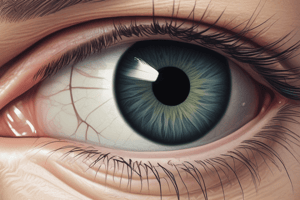Podcast
Questions and Answers
Why do we assess the 6 cardinal fields of gaze?
Why do we assess the 6 cardinal fields of gaze?
To assess how well the ocular muscles of the eyes are working and to evaluate cranial nerves III, IV, and VI.
What movement does the superior rectus muscle perform?
What movement does the superior rectus muscle perform?
- Upward (correct)
- Outward
- Inward
- Downward
Which muscles move the eye downward?
Which muscles move the eye downward?
- Superior Rectus
- Inferior Rectus (correct)
- Inferior Oblique
- Superior Oblique (correct)
What is the procedure for eye muscle assessment?
What is the procedure for eye muscle assessment?
What does a normal result look like during eye muscle assessment?
What does a normal result look like during eye muscle assessment?
Abnormal eye muscle assessment results indicate smooth movement of the eyes.
Abnormal eye muscle assessment results indicate smooth movement of the eyes.
Study Notes
Assessment of Cardinal Fields of Gaze
- Evaluates the function of ocular muscles to assess cranial nerves III (oculomotor), IV (trochlear), and VI (abducens).
- Essential for determining eye movement efficiency and coordination.
Muscles of the Human Eye
- Superior Rectus: Responsible for upward movement.
- Superior Oblique: Facilitates downward and outward movement.
- Medial Rectus: Controls inward movement towards the nose.
- Inferior Rectus: Responsible for downward movement.
- Inferior Oblique: Allows upward and outward movement.
- Lateral Rectus: Controls outward movement away from the nose.
Conducting Eye Muscle Assessment
- Use a penlight positioned 12-14 inches from the patient's face.
- Ensure the patient's head remains straight; only eye movements should occur.
- Begin assessment from the midline position, following a specific movement pattern:
- Right upper to left lower.
- Left upper to right lower.
- Side-to-side movements.
Interpreting Eye Muscle Assessment Results
- Normal Findings: Smooth tracking of the penlight indicates effective ocular muscle function.
- Abnormal Findings: Involuntary eye shaking (nystagmus) may indicate disorders in ocular control or neurological issues.
Studying That Suits You
Use AI to generate personalized quizzes and flashcards to suit your learning preferences.
Description
This quiz focuses on the assessment of the cardinal fields of gaze and the functionalities of ocular muscles relevant to cranial nerves. You will explore eye movement efficiency, muscle responsibilities, and the methods used to conduct eye muscle assessments. Ideal for students in fields related to anatomy or ophthalmology.




